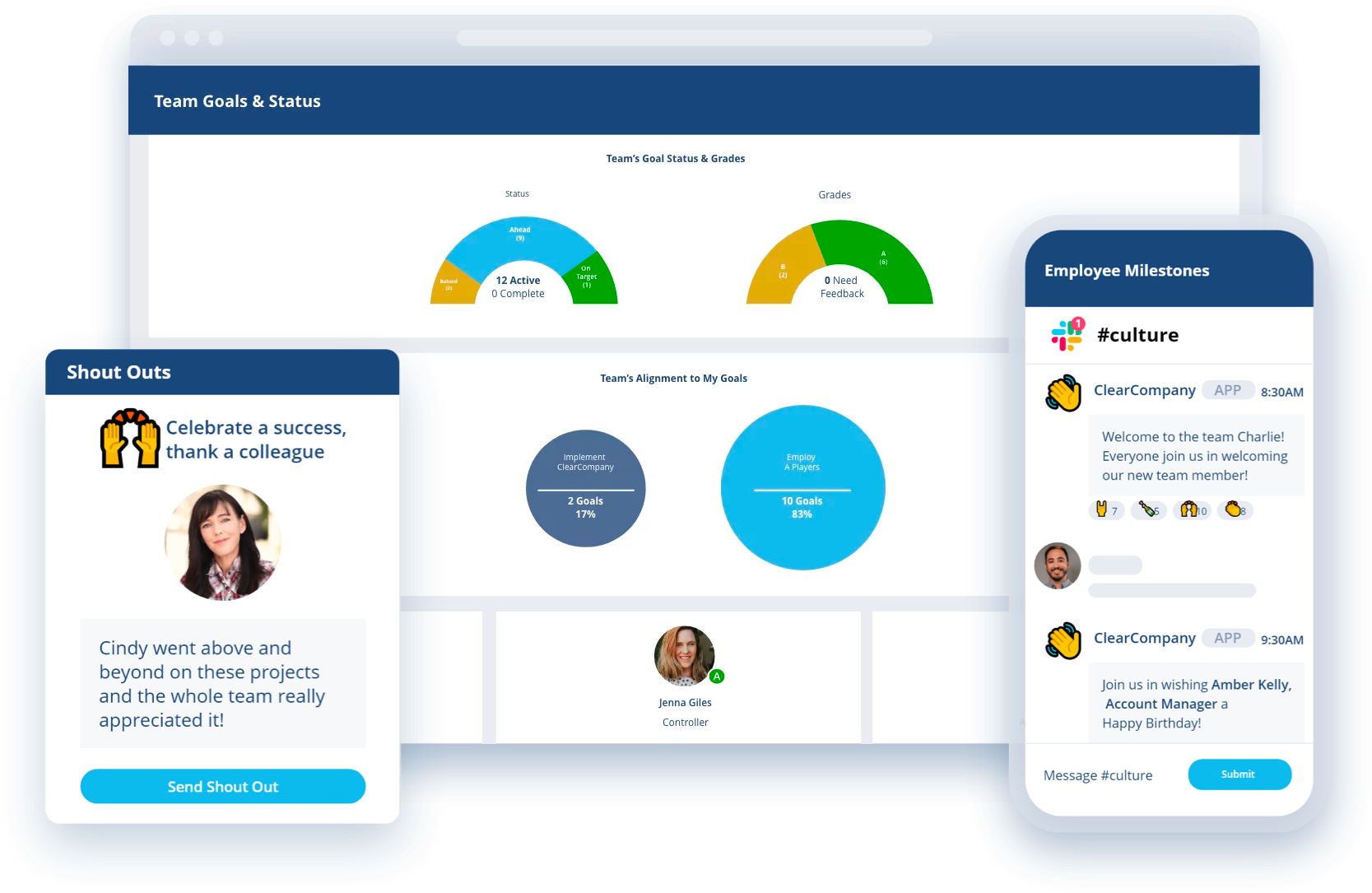This post about the importance of employee engagement was originally published in October 2022. It was updated with new information in January 2024.
There’s no need to explain to an HR professional that a business’s employees have the biggest impact on its success. Engaged employees are more productive, less likely to quit, and report better well-being. High engagement correlates with higher employee satisfaction and customer satisfaction, fewer safety incidents, and even higher company profitability.
However, it’s not easy to measure and maintain employee engagement. Not to mention, it’s been a tumultuous few years for employee engagement in the U.S. The engagement rate climbed steadily for over a decade until early 2020, dropping from 36% to 32% in late 2022. The number of actively disengaged employees also rose, reaching 18%.
Engagement is trending up again, hovering between 33-34% in 2023. Active disengagement also started to improve, falling from 18% to 16%. CHROs are divided on what they think will happen going into 2024:
- 31% expect employee engagement to decrease.
- 37% expect engagement to increase.
- 32% say it won’t change.
Though they may not agree on what direction it’s heading, HR leaders do agree that employee engagement strategies matter. 75% said improving the employee experience and company culture is a top priority in 2024. As employees express a lack of trust in management and fears about artificial intelligence (AI) displacing their jobs, it’s essential to increase engagement efforts to build trust and put their fears at ease.
Keep reading to learn more about why employee engagement is important and tips on how to engage your employees.
Employee Engagement: The Basics
Employee engagement refers to the level of connection and excitement individuals feel toward their work and workplace. Your people want to be engaged —to feel connected to their work, valued for what they do, and have their voices heard. They want clear expectations and growth opportunities. Simply put, they want to feel supported by their employers as human beings.
Effective employee engagement programs are incredibly beneficial for the work environment and the business as a whole. Highly engaged workers are more productive and creative, and they’re less likely to look for a new job. Companies with high levels of employee engagement are more profitable, experience fewer safety incidents, and have more loyal customers.
Discover easy ways to harness the power of employee engagement at your organization —
click to get your resource bundle.
But you can’t reap these benefits of employee engagement without a plan and participation from your management team. Global analytics and advice firm Gallup discovered that managers alone are responsible for 70% of the variance in engagement on their teams. That means managers need to take an active role in improving employee engagement and ensuring it stays as high as possible.
Luckily, Gallup also identified 12 necessities that, when met, result in a highly engaged workforce. Here’s what managers need to do to foster high engagement based on those 12 needs:
- Set clear expectations for every employee.
- Provide sufficient materials and equipment.
- Give employees a chance to do their best each day.
- Offer recognition or praise at least once a week.
- Demonstrate that they care about their employees as people.
- Encourage employees’ development.
- Ask for employees’ opinions and take them into account.
- Connect projects and goals to the company mission.
- Demonstrate their own commitment to doing great work.
- Help employees develop close relationships at work.
- Discuss performance on a regular basis and evaluate progress with performance reviews.
- Help employees set goals for their growth and identify career paths.
Just from these basics, it's clear that employee engagement is an ongoing process, not a one-time project. You’ll need to adapt your strategies as the needs of employees and the business change and as the world of work evolves. Understanding the importance of employee engagement and its impact can help your organization do just that.
Let’s take a closer look at how the power of employee engagement impacts the entire organization. We’ll also explore some of the ways you can measure and increase employee engagement.
1. Shape Company Culture
Employee engagement is at the core of company culture. Think about it — if a majority of your team members feel happy, supported, and important at work, that will naturally encourage other traits of a strong company culture:
- Deeper connections and trust among colleagues
- Better employee communication across the organization
- Higher levels of innovation
- More employee recognition, both from people leaders and peers
In this positive feedback loop, when the company culture is healthy, engagement is also higher, with improvements to one strengthening the other. Be sure to identify your company culture and incorporate it into recruiting materials to start building engagement during the application process.
But don’t check it at the door when the offer letter is signed. Embed company culture into every part of the employee experience to strengthen their connection with their work. Here are a few ways to do that:
- Send employee engagement surveys after transitions, for example, when new hires complete onboarding or after an employee moves to another department or role.
- Create an employee recognition strategy and make it easy for peers and supervisors to support and celebrate each other regularly.
- Pair new hires with a mentor, a more seasoned employee who can show them the ropes and provide guidance in their new workplace.
2. Motivate Your Employees
Motivation pushes employees to do their very best at work. If you look back at the list of 12 things managers can do to engage their employees, it’s clear why engaged employees are highly motivated. They have everything they need, they know how they’re doing, and they know where to find help. In addition, their work isn’t going unnoticed — employees know that their managers and peers see and appreciate their contributions.
It’s also motivating for employees to see their direct connection to furthering the company mission. When their goals are aligned with business goals, there’s no ambiguity about why their job is important — they can see for themselves why their work matters.
3. Improve Employee Performance
Just like highly engaged employees are motivated to do their best on a daily basis, they’re also motivated to improve their performance and become high performers. The data backs that up, too — highly engaged sales teams, for example, are up to 18% more productive than those with low engagement, and research shows that engaged employees are 27% more likely to say their performance was excellent.
When performance conversations are frequent and transparent, and growth opportunities abound, employees have the means and the motivation to get even better at what they do. Making your people feel heard, giving them feedback as they work instead of once a year, and taking action to help them grow are all essential for improving employee performance and fostering a motivated, engaged workforce.
4. Retain Top Talent
It’s no surprise that employees stay longer at companies that meet their needs. Who would want to quit a workplace where they feel invested in and appreciated? Evidence shows that employee retention is as much as 34% higher when they have professional development opportunities alone.
Advancement opportunities are also one of the top considerations for job seekers and a major reason many employees are searching elsewhere. And that’s based on just one aspect of employee engagement — imagine the retention benefits when all 12 requirements of high engagement are met.
5. Save Time and Money
Considering its positive impact on motivation, performance, and retention, you may have already guessed that higher engagement can save significant time and money, especially for HR teams. Engaged teams are staying longer and learning new skills during their tenure, reducing the cost and time spent hiring new employees to fill open roles or close skills gaps. Employees are getting more work done while continuously getting better at it, increasing production while reducing time and money spent fixing mistakes.
The Importance of Employee Engagement Software
It’s almost an understatement to say engagement is important. It’s hard to find a part of employee experience or a business outcome that isn’t impacted by your company’s engagement levels. Engagement even affects your clients’ satisfaction and longevity. As we work to reach —and hopefully surpass — pre-pandemic engagement levels, there’s never been a better time to bring it to the forefront as a business priority.
As the saying goes, modern problems require modern solutions, and that’s why you need the most modern solution to bolster your engagement efforts. Employee engagement software can help your organization measure and evaluate engagement trends and provide insights that help you develop more effective strategies. You can use software to measure employee engagement quickly and regularly without putting a strain on your HR team.
One of the biggest benefits of using employee engagement software is that your company’s valuable engagement data is turned into powerful reports. These reports would take a massive amount of time for your team to produce manually, not to mention the effort it would take to gather the data in the first place. But with software, the data’s all there, and it takes just a few clicks.
Get access to all of these Employee Engagement tools and more with ClearCompany:
- Celebrations and Shout Outs make it easy to build recognition and encouragement into the company culture.
- Employee Survey tools, including prebuilt survey templates and eNPS pulse surveys, allow for the fast creation and launch of anonymous surveys.
- Goal Planning tools clarify employees’ duties and show how they contribute to business success.
- Robust reporting and analytics provide actionable insights from real engagement data and enable more informed decision-making regarding HR strategies.
Experience ClearCompany's Employee Engagement tools and features firsthand — sign up for a demo with one of our experts.



